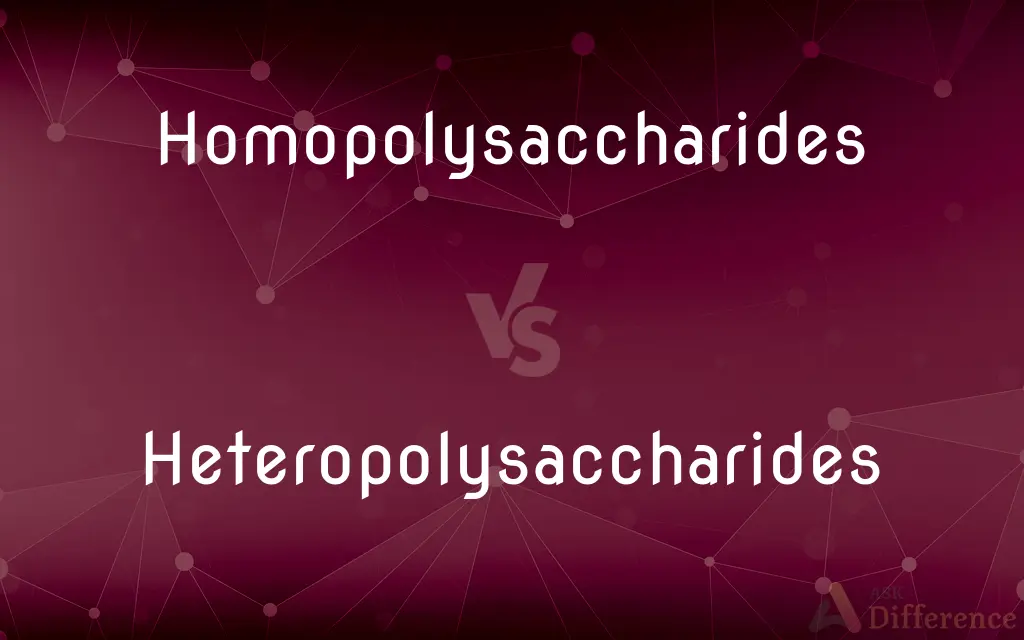Homopolysaccharides vs. Heteropolysaccharides — What's the Difference?
By Tayyaba Rehman — Published on December 21, 2023
Homopolysaccharides are made of a single type of monosaccharide; Heteropolysaccharides consist of different monosaccharides.

Difference Between Homopolysaccharides and Heteropolysaccharides
Table of Contents
ADVERTISEMENT
Key Differences
Homopolysaccharides are polysaccharides that consist of only one type of monosaccharide unit. This means that their entire structure is composed of repeated units of a singular sugar molecule. Examples of Homopolysaccharides include cellulose, glycogen, and starch. These types of polysaccharides are often used by organisms as storage molecules or structural elements.
Heteropolysaccharides, in contrast, are polysaccharides that are composed of more than one type of monosaccharide. This makes their structure more varied, with different sugar units joining to form the polymer. Common examples of Heteropolysaccharides include hyaluronic acid, chondroitin sulfate, and heparin. They usually play diverse roles in biological systems, from structural components to being involved in specific physiological processes.
When considering their function, Homopolysaccharides are primarily involved in energy storage and providing structural support in plants and animals. Since they are composed of only one type of sugar, they tend to have a consistent structure that's optimized for these roles. Glycogen, for instance, is a Homopolysaccharide that acts as the primary storage form of glucose in animals.
Heteropolysaccharides, given their varied composition, often have more specialized roles in biological systems. They can be found in the extracellular matrix of cells, in connective tissues, and as components of various biological fluids. Due to their diverse monosaccharide content, Heteropolysaccharides can engage in more specific interactions within biological systems.
Comparison Chart
Monosaccharide Composition
Single type of monosaccharide
Multiple types of monosaccharides
ADVERTISEMENT
Structural Consistency
Consistent structure
Varied structure
Examples
Cellulose, glycogen, starch
Hyaluronic acid, chondroitin sulfate, heparin
Primary Functions
Energy storage and structural support
Structural components, physiological processes
Location in Organisms
Within cells for energy or as structural elements
Extracellular matrix, connective tissues, biological fluids
Compare with Definitions
Homopolysaccharides
Homopolysaccharides are polysaccharides composed solely of one type of monosaccharide.
Cellulose, found in plant cell walls, is a type of Homopolysaccharides made entirely of glucose units.
Heteropolysaccharides
Heteropolysaccharides can interact in specific ways in biological systems due to their varied sugar units.
The Heteropolysaccharides component of bacterial cell walls can trigger specific immune responses.
Homopolysaccharides
Homopolysaccharides serve as primary energy storage or structural molecules in organisms.
The liver stores excess glucose as the Homopolysaccharides, glycogen.
Heteropolysaccharides
Heteropolysaccharides are polysaccharides made up of more than one type of monosaccharide.
Heparin, a Heteropolysaccharides, contains various sugar molecules, playing a role in anticoagulation.
Homopolysaccharides
In Homopolysaccharides, the repeated sugar units are identical.
Starch, a Homopolysaccharides, consists only of glucose molecules linked together.
Heteropolysaccharides
Heteropolysaccharides often play specialized roles in biological processes.
Hyaluronic acid, a Heteropolysaccharides, is crucial for skin hydration and joint lubrication.
Homopolysaccharides
Homopolysaccharides are often insoluble in water and have a consistent structure.
Due to its consistent glucose chain, the Homopolysaccharides cellulose provides strength to plant cell walls.
Heteropolysaccharides
In Heteropolysaccharides, the composition can vary, leading to diverse functionalities.
Chondroitin sulfate, a Heteropolysaccharides, contributes to the resilience of cartilage.
Homopolysaccharides
Homopolysaccharides have a uniform composition, ensuring specific functionalities in organisms.
Plants use the Homopolysaccharides starch as an energy reserve, thanks to its singular glucose composition.
Heteropolysaccharides
Heteropolysaccharides often reside outside cells, contributing to structural or physiological roles.
Many Heteropolysaccharides, like hyaluronic acid, form essential parts of the extracellular matrix.
Homopolysaccharides
Plural of homopolysaccharide
Heteropolysaccharides
Plural of heteropolysaccharide
Common Curiosities
What are Homopolysaccharides?
Homopolysaccharides are polysaccharides composed of only one type of monosaccharide.
How do Heteropolysaccharides differ from Homopolysaccharides?
Heteropolysaccharides contain multiple types of monosaccharides, while Homopolysaccharides consist of just one type.
Can Heteropolysaccharides be involved in immune responses?
Yes, certain Heteropolysaccharides, especially in bacterial cell walls, can trigger immune reactions.
What's a common role of Homopolysaccharides in organisms?
Homopolysaccharides often function in energy storage or providing structural support.
Can Homopolysaccharides be found in plants?
Yes, plants contain Homopolysaccharides like cellulose and starch.
Are all polysaccharides either Homopolysaccharides or Heteropolysaccharides?
Yes, based on monosaccharide composition, polysaccharides can be categorized as either Homopolysaccharides or Heteropolysaccharides.
Do Heteropolysaccharides play roles in skin and joint health?
Yes, Heteropolysaccharides like hyaluronic acid are vital for skin hydration and joint lubrication.
Are there any medicinal uses for Heteropolysaccharides?
Yes, Heteropolysaccharides like heparin are used as anticoagulants in medicine.
Where might you commonly find Heteropolysaccharides in the body?
Heteropolysaccharides are frequently found in the extracellular matrix, connective tissues, and biological fluids.
Are all Homopolysaccharides insoluble in water?
While many Homopolysaccharides are insoluble, not all are. For instance, certain forms of starch can be water-soluble.
What provides the strength to plant cell walls, Homopolysaccharides or Heteropolysaccharides?
The strength of plant cell walls is provided by the Homopolysaccharides, cellulose.
Can both Homopolysaccharides and Heteropolysaccharides be found in the same organism?
Yes, both types of polysaccharides can coexist within the same organism, serving different functions.
Are Heteropolysaccharides typically more diverse in structure than Homopolysaccharides?
Yes, due to the inclusion of different monosaccharides, Heteropolysaccharides generally have a more varied structure.
Is cellulose a type of Homopolysaccharides or Heteropolysaccharides?
Cellulose is a type of Homopolysaccharides.
Which type of polysaccharide, Homopolysaccharides or Heteropolysaccharides, is primarily used for energy storage in animals?
Homopolysaccharides, specifically glycogen, serve as the primary energy storage in animals.
Share Your Discovery

Previous Comparison
Pellet vs. Granule
Next Comparison
Independent Variable vs. Dependent VariableAuthor Spotlight
Written by
Tayyaba RehmanTayyaba Rehman is a distinguished writer, currently serving as a primary contributor to askdifference.com. As a researcher in semantics and etymology, Tayyaba's passion for the complexity of languages and their distinctions has found a perfect home on the platform. Tayyaba delves into the intricacies of language, distinguishing between commonly confused words and phrases, thereby providing clarity for readers worldwide.
















































